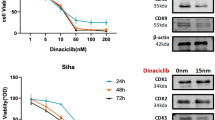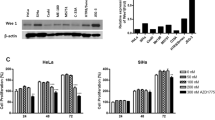Abstract
The aim of this study was to investigate the effect of dihydrotanshinone I (DI) in inhibiting the growth of human cervical cancer cells both in vitro and in vivo, and molecular targets in HeLa cells when treated by DI or irradiation with or without being combined. In this study, MTT, clonogenic assay, flow cytometry, and Western blotting were performed to assess the effect of treatment on cells. After treatment with IR, DI, and DI + IR, the apoptosis was 5.8, 13.3 and 22.5% (P < 0.05 vs. control), respectively. Clonogenic assay revealed that the survival of irradiated HeLa cell was significantly reduced by DI treatment. Combination treatment with IR and DI could down-regulate HPV E6 gene expression. Effect of DI on up-regulation of p21 expression and down-regulation of cyclin B1, p34cdc2 expression in irradiated HeLa cell was concomitant with cell cycle arrest in G2 phase. The significant increase in caspase-3 activity was also observed in the combination treatment. When HeLa cells were grown as xenografts in nude mice, combination treatment with DI and IR induced a significant decrease in tumor growth, and without signs of general or organ toxicity. These data suggest DI should be tested as the radiosensitizer in vitro and in vivo, which has potential in the treatment of human cervical cancer.







Similar content being viewed by others
References
Liu SS, Leung RC, Chan KY, Chiu PM, Cheung AN, Tam KF (2004) P53 expression is associated with the cellular radiosensitivity in cervical cancer after radiotherapy. Clin Cancer Res 10:3309–3316
Kim TJ, Lee JW, Song SY, Choi JJ, Choi CH, Kim BG et al (2006) Increased expression of pAKT is associated with radiation resistance in cervical cancer. Br J Cancer 94:1678–1682
Uno T, Isobe K, Yamamoto S, Kawata T, Ito H (2006) Postoperative radiation therapy for carcinoma of the uterine cervix. Radiat Med 24:91–97
Zhong YH, Liao ZK, Zhou FX, Xie CH, Xiao CY, Pan DF, Luo ZG, Liu SQ, Zhou YF (2008) Telomere length inversely correlates with radiosensitivity in human carcinoma cells with the same tissue background. Biochem Biophys Res Commun 367:84–89
Green J, Kirwan J, Tierney J, Vale C, Symonds P, Fresco L et al (2005) Concomitant chemotherapy and radiation therapy for cancer of the uterine cervix. Cochrane Rev 3:222–225
Loizzi V, Cormio G, Loverro G, Selvaggi L, Disaia PJ, Cappuccini F (2003) Chemoradiation:a newapproach for the treatment of cervical cancer. Int J Gynecol Cancer 13:580–586
Rose PG (2006) Concurrent chemoradiation for locally advanced carcinoma of the cervix: where are we in 2006? Ann Oncol 17 (Suppl):224–229
Chan K, Chui SH, Wong DY, Ha WY, Chan CL, Wong RN (2004) Protective effects of Danshensu from the aqueous extract of Salvia miltiorrhiza (Danshen) against homocysteine-induced endothelial dysfunction. Life Sci 75:3157–3171
Xu M, Wang YP, Luo WB, Xuan LJ (2001) Salvianolate inhibits proliferation and endothelin release in cultured rat mesangial cells. Acta Pharmacol Sin 22:629–633
Xia ZY, Gu JZ, Ansley DM, Xia F, Yu JF (2003) Antioxidant therapy with Salvia miltiorrhiza decreases plasma endothelin-1 and thromboxane B2 after cardiopulmonary bypass in patients with congenital heart disease. J Thorac Cardiovasc Surg 126:1404–1410
Wang L (2008) Dissection of mechanisms of Chinese medicinal formula Realgar-Indigo naturalis as an effective treatment for promyelocytic leukemia. Proc Natl Acad Sci 105:4826–4831
Liu JJ (2006) Induction of apoptosis and inhibition of cell adhesive and invasive effects by tanshinone IIA in acute promyelocytic leukemia cells in vitro. J Biomed Sci 13:813–823
Mosaddik MA (2003) In vitro cytotoxicity of tanshinones isolated from Salvia miltiorrhiza Bunge against P388 lymphocytic leukemia cells. Phytomedicine 10:682–685
Lee SY, Choi DY, Woo ER (2005) Inhibition of osteoclast differentiation by tanshinones from the root of Salvia miltiorrhiza Bunge. Arch Pharm Res 28:909–913
Munoz N, Bosch FX, de Sanjose S, Herrero R, Castellsague X, Shah KV, Snijders PJ, Meijer CJ (2003) Epidemiologic classification of human papillomavirus types associated with cervical cancer. New Engl J Med 348:518–527
Shiah SG, Chuang SE, Kuo ML (2001) Involvement of Asp-Glu-Val-Asp-directed, caspase-mediated mitogen-activated protein kinase 1 cleavage, c-Jun N-terminal kinase activation, and subsequent Bcl-2 phosphorylation for paclitaxel-induced apoptosis in HL-60 cells. Mol Pharmacol 59:254–262
Su LN, Little JB (1993) Prolonged cell cycle delay in radioresistant human cell lines transfected with activated ras oncogene and/or simian virus 40 T-antigen. Radiat Res 133:73–79
Shukla S, Gupta S (2007) Apigenin-induced cell cycle arrest is mediated by modulation of MAPK, PI3K-Akt, and loss of cyclin D1 associated retinoblastoma dephosphorylation in human prostate cancer cells. Cell Cycle 6:1102–1114
Wang CL, Ng TB, Yuan F, Liu ZK, Liu F (2007) Induction of apoptosis in human leukemia K562 cells by cyclic lipopeptide from Bacillus subtilis nattoT-2. Peptides 28:1344–1350
Fukuchi K, Watanabe H, Tomoyasu S et al (2000) Phosphotidyl 3-kinase inhibitors, Wortmannin or LY294002, inhibited accumulation of p21 protein after irradiation by stabilization of the protein. Biochim Biophys Acta 1496:207–220
Narvaez CJ, Welsh J (2001) Role of mitochondria and caspases in vitamin D-mediated apoptosis of MCF-7 breast cancer cells. J Biol Chem 276:9101–9107
Benzina S, Altmeyer A, Malek F, Dufour P, Denis J-M, Bischoff P et al (2008) High-LET radiation combined with oxaliplatin induce autophagy in U-87 glioblastoma cells. Cancer Lett 264:63–70
Chun YJ, Park IC, Park MJ, Woo SH, Hong SI (2002) Enhancement of radiation response in human cervical cancer cells in vitro and in vivo by arsenic trioxide (As2O3). FEBS Lett 519:195–200
Chendil D, Ranga RS, Meigooni D (2004) Curcumin confers radiosensitizing effect in prostate cancer cell line PC-3. Oncogene 23:1599–1607
Garg AK, Buchholz TA, Aggarwal BB (2005) Chemosensitization and radiosensitization of tumors by plant polyphenols. Antioxid Redox Signal 7:1630–1647
Sandhya T, Lathika KM, Pandey BN et al (2006) Protection against radiation oxidative damage in mice by Triphala. Muta Res Lett 609:17–25
Garg AK, Hortobagyi GN, Aggarwal BB (2003) Nuclear factor-kappa B as a predictor of treatment response in breast cancer. Curr Opin Oncol 15:405–411
Jahnukainen K, Chrysis D, Hou M, Parvinen M, Eksborg S (2004) Increased apoptosis occurring during the first wave of Spermatogenesis is stage-specific and primarily affects midpachytene spermatocytes in the rat testis. Biol Reprod 70:290–296
Dudgeon C, Kek C, Demidov ON, Saito S, Fernandes K (2006) Tumor susceptibility and apoptosis defect in a mouse strain expressing a human p53 transgene. Cancer Res 66:2928–2936
Sinha AP, Swerdloff RS (1999) Hormonal and genetic control of germ cell apoptosis in testis. Rev Reprod 4:38–47
Kaufmann SH, Hengartner MO (2001) Programmed cell death: alive and well in the new millennium. Trends Cell Biol 11:526–534
Lee EO, Kwon BM, Song GY, Chae CH, Kim HM, Shim IS et al (2004) Heyneanol A induces apoptosis via cytochrome c release and caspase activation in human leukemic U937 cells. Life Sci 74:2313–2326
Pawlik TM, Keyomarsi K (2004) Role of cell cycle in mediating sensitivity to radiotherapy. Int J Radiat Oncol Biol Phys 59:928–942
Seiwert TY, Salama JK, Vokes EE (2007) The concurrent chemoradiation paradigm general principles. Nat Clin Pract Oncol 4:86–100
Arango D, Wilson AJ, Shi Q et al (2004) Molecular mechanisms of action and prediction of response to oxaliplatin in colorectal cancer cells. Br J Cancer 91:1931–1946
Voland C, Bord A, Peleraux A et al (2006) Repression of cell cyclerelated proteins by oxaliplatin but not cisplatin in human colon cancer cells. Mol Cancer Ther 5:2149–2157
Zhang GS, Zhou GB, Dai CW (2004) Upregulation and activation of caspase-3 or caspase-8 and elevation of intracellular free calcium mediated apoptosis of indomethacin-induced K562 cells. Chin Med J 117:978–984
Antonella M, Francesca B, Claudia B, Ludovica G, Antonella T, Simona B et al (2006) Conjugated linoleic acid induces apoptosis in MDA-MB-231 breast cancer cells through ERK/MAPK signalling and mitochondrial pathway. Cancer Lett 234:149–157
René H, Ute G, Heidrun F, Barbara G, Peter T, Daniel et al (2009) Combined action of celecoxib and ionizing radiation in prostate cancer cells is independent of pro-apoptotic Bax. Radiother Oncol 90:413–421
Brockhaus F, Brune B (1998) U937 apoptotic cell death by nitric oxide: Bcl-2 downregulation and caspase activation. Exp Cell Res 238:33–41
Chen GQ, Zhu J, Shi XG, Ni JH, Zhong HJ, Jin XL et al (1996) In vitro studies on cellular and molecular mechanisms of arsenic trioxide (As2O3) in the treatment of acute promyelocytic leukemia: As2O3 induces NB4 cell apoptosis with downregulation of Bcl-2 expression and modulation of PML-RAR alpha/PML proteins. Blood 88:1052–1061
Filomeni G, Rotilio G, Ciriolo MR (2003) Glutathione disulfide induces apoptosis in U937 cells by a redox-mediated p38 MAP kinase pathway. FASEB J 17:64–66
Huang DC, Strasser A (2000) BH3-only proteins-essential initiators of apoptotic cell death. Cell 103:839–842
Sumiti K, Bansal MP (2009) Regulation of apoptosis by Caspases under oxidative stress conditions in mice testicular cells: in vitro molecular mechanism. Mol Cell Biochem 322:43–52
Park S-G, Jung J-J, Won HJ, Kang MS, Seo S-K (2009) Tetra-arsenic oxide (Tetras) enhances radiation sensitivity of solid tumors by anti-vascular effect. Cancer Lett 277:212–217
Acknowledgments
Thanks to Prof. Chen Wang for providing advice and her technical assistance, and all members of the laboratory for insightful suggestions. This research was supported by grants from the key project of Tianjin science and technology support (2010KZ75).
Author information
Authors and Affiliations
Corresponding author
Rights and permissions
About this article
Cite this article
Ye, Y., Xu, W., Zhong, W. et al. Combination treatment with dihydrotanshinone I and irradiation enhances apoptotic effects in human cervical cancer by HPV E6 down-regulation and caspases activation. Mol Cell Biochem 363, 191–202 (2012). https://doi.org/10.1007/s11010-011-1171-0
Received:
Accepted:
Published:
Issue Date:
DOI: https://doi.org/10.1007/s11010-011-1171-0




